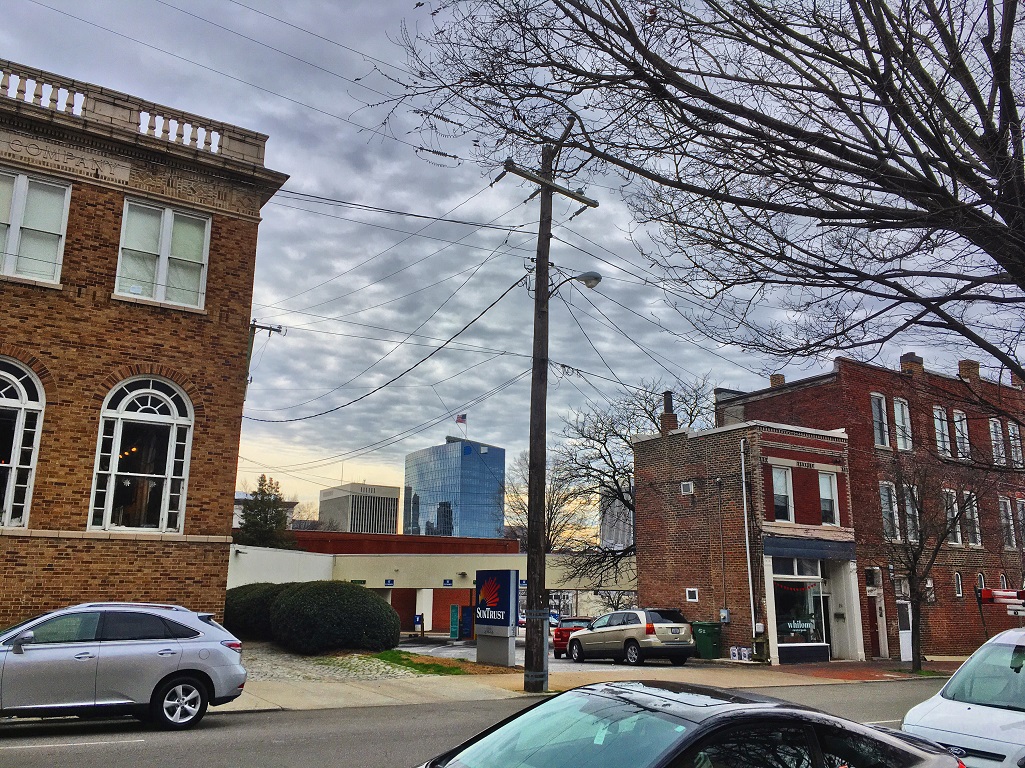The eleventh and penultimate installment in a monthly series in which a hometown Richmonder who has spent over a decade abroad explores the many different neighborhoods accessible by GRTC bus lines to discover the ways transit connects us all.
Carytown:
Given just one day to show a tourist around town, it’s hard to imagine any classic Richmond visit would be complete without a stroll through Carytown. This eclectic nine-block stretch of locally-owned businesses represents the city in a way few neighborhoods can. Its effortless blending of chic and quirky have become iconic for Richmond’s rebranding from the former capital of the Confederacy to a modern hipster mecca on par with Austin or Portland.
Serving as the anchor of the area, the Byrd Theatre has proudly stood watch over nearly a century of change. Built in 1928 in the French Empire style at a cost of $900,000, Richmond’s premier movie palace embodies the community spirit that has preserved and promoted Carytown’s transformation into a cultural and commercial destination.
The opening of the Cary Court strip mall in the 1930s felt like a revolution at the time. Back then the beloved corner stores that still abound in the Fan and Church Hill were the only way to shop. Cary Court’s grocery with a dedicated parking lot out front was a first for the city. Although the stores in that strip mall have continuously evolved over the years, the culture of car-centric planning that the development ushered in has held on.
As the Henrico suburbs to the city’s west proliferated during the post-World War II era of white flight, Richmond’s leadership began kowtowing to the needs of commuters from the counties rather than preserve the city’s walkable neighborhoods for those residents who remained. In 1955, Cary Street was flipped to be a one-way corridor channeling cars straight to downtown. The change proved detrimental to the area’s ambience and air quality, and the increased traffic caused homeowners to move away. Their former abodes transitioned into the shops one sees today.
This corner of the city only came to think of itself as a cohesive neighborhood with a shared identity 46 years ago. Willow Lawn — Richmond’s first mall — slowly sapped the life out of retail strips across the city, triggering this stretch of West Cary to undertake a rebrand in 1974. To fight back and generate a new buzz and energy, residents voted in favor of a new name for the area: Carytown.
The decay continued throughout the 1980s, however, until locals no longer deemed the area safe for shopping. This emptying out of Carytown created new space for up and coming businesses like gay bars and dance clubs, but after a sex shop opened its doors along the strip, local business owners quickly joined together to shutter the establishment by dramatically cutting off all electrificity to the structure. This action proved a clear signal residents and shop owners aimed to steer the neighborhood in a definitively family-friendly direction.
These days all kinds come to eat, shop, and people watch along Cary Street. For the longest time, this stretch of retail proved the only safe space for same-sex couples to hold hands in Richmond. Thanks to Carytown’s laissez faire culture of acceptance and its smattering of gay bars — of which only Babe’s and New York Deli remain — many locals estimate that the neighborhood has become the closest thing to a “gayborhood” the city offers.
Carytown’s lasting success derives from its branding as a place not just to shop, but to experience. Even as chain stores and national brands have slowly crept in to Richmond’s “Mile of Style,” most of the area’s 230-plus outlets remain in local hands. Spas, unique eateries, and charming local shops like Mongrel and World of Mirth have set the tone for the neighborhood as a friendly, welcoming place to explore all the creativity and charm of the city.
What holds Carytown back from being a world class destination is the area’s addiction to car culture. Although most people stroll its blocks from end to end, the experience of someone on foot feels far from safe. Drivers speed down Cary with abandon, crossings are inadequate, and the majority of the street is planned for cars, not people.
A braver Richmond would overcome the trauma of white flight and rework its premier shopping destination into a place that people could traverse without fear of a car plowing over the sidewalk and into a local business, as happened to the Daily Kitchen & Bar a few years back. Residents and business owners’ calls for traffic calming measures like speed humps went unanswered.
They haven’t painted the lines on Cary St in Carytown yet. Still time to stripe bus only lanes down the middle and multi use lanes on the curb 👀👀👀👀
— Doug Allen (@DFRSH757) November 28, 2019
New York City recently tackled its notoriously awful 14th Street by converting it into a busway with wider sidewalks and lanes for bikes and scooters. It’s not hard to imagine something similar working in Carytown. Gone would be the curbside car storage, and in its place, a grand pedestrian promenade. GRTC’s Route 5 bus would still pass through, but Cary would be a far quieter, more enjoyable, and safer street for all to travel.
The Ride:
With a scone in my belly and a coffee in hand, I departed Sugar & Twine with a smile on my face. The people-watching in Carytown can be hit or miss on a Saturday morning, depending on whether you show up before or during the time when the brunch crowd reigns supreme. After a leisurely stroll on an abnormally warm and sunny winter day, I opened the Transit App to catch the 5 downtown.
By sheer luck, the next bus was just two minutes away. The 15-minute frequency of the 5 feels like such a carefree luxury compared to the hourly routes that serve as the only lifeline to communities on Southside and in Henrico. There’s no need to plan ahead for your departure when your average wait time is just seven and a half minutes.
Boarding the bus I got a friendly hello from a stylish driver with golden horn-rimmed glasses. I quickly scanned my monthly pass from my phone and took a seat over the wheel well, a perfect perch from which to survey my fellow riders. The bus was full; its cast of characters seemed split between heading home after a late night and getting an early start to their day.
We cruised down Cary Street, never going more than five miles per hour over the speed limit as cars whizzed past on our left. The transformation of Cary and Main from neighborhood streets into mini crosstown highways proves most visible around Allen Street. Bagel lovers marching to Nate’s as part of their weekend ritual too frequently get caught in a game of Frogger, dodging speeding vehicles to reach their everything with cream cheese and lox.
Alighting the 5 next to the Pocahontas Building, which houses the General Assembly until its new abode is complete, it’s easy to forget that the ease of this 18-minute trip is not standard across the capital of the Commonwealth. This route is just one of five in GRTC’s entire system which achieve such frequency.
In many ways Route 5 is a vision of the transit service every neighborhood in the region deserves. Its 15-minute frequencies — at least Monday through Saturday till 7pm — from end to end are also a rarity. More buses generally translate into more riders. More heavily traveled routes like the 1, the 2, and the 3 only achieve that distinction when you add up all their alphabetical variations.
Studies have shown people are first willing to give up their car for transit only when a bus comes at least once every fifteen minutes. Gaps any longer than that start to add up when your bus doesn’t come, or you just miss it, especially if you have to time a transfer perfectly. The frequency of the 5 means freedom for the communities along its path.
My friend Amber, who lives in Carytown, told me she couldn’t imagine moving to a place off of this route. Compared to her $60 a month bus pass, the expenses of owning, repairing, parking, and fueling a car feel daunting. Thousands of people just like her in the Fan, the Museum District, Randolph, Oregon Hill, Downtown, and the East End rely upon this bus for their mobility, not because they have to but because it’s a more affordable, social, and comfortable way to travel.
Frequent service like that of the 5 shouldn’t just be a perk of living along its path; its 15-minute intervals should be a baseline expectation for bus service citywide to foster a more equitable and sustainable capital city.
Downtown:
Long before English colonists claimed the banks of the James in present-day Richmond, the area around our downtown already served as an important settlement of the Powhatan Confederacy. Located perfectly along the boundary between Virginia’s Tidewater and Piedmont regions, geography preordained Richmond to become a key economic and political center.
Following the Revolutionary War, the newly independent state shifted its capital from Williamsburg further inland to Richmond to protect its government and commercial capital from sea-faring attackers. Just two decades after this designation, the increasing concentration of political and economic power in Richmond triggered a building boom.
Powered by Shockoe Bottom — the largest and most famous slave trade market in the nation — Richmond rapidly exploded into one of the fledgling country’s biggest and wealthiest cities. With the South’s traitorous declaration of secession from the Union, the city descended to the status of a military town. Soldiers, spies, and ad hoc military hospitals abounded until the Confederacy’s cowardly retreat, in which they engaged in a literal scorched-earth campaign to burn Richmond to the ground before it fell to Union forces. Northern troops fought back the blaze, but 80 percent of the city already lay in ashes.
During the prosperous and unusually democratic Reconstruction era that followed, Richmond once again flourished. Finance, retail, and banking took the place of the slave trade, filling downtown blocks with ornamented homes and businesses of brick. The 1920s ushered in a proliferation of Art Deco skyscrapers like the 19-story First National Bank Building.
Suburbanization and the rise of car culture struck here too, marked by the gradual closure of the area’s many high end department stores, like Thalhimers, Sears, and Miller & Rhoads. Hundreds of structures were demolished over the course of the 1960s to 1980s to make way for 600-plus new buildings and their associated parking garages and surface lots. Most notable among these are City Hall, the aluminum-covered Federal Reserve Bank, and the hideous James Monroe Building, whose second tower never materialized when the boom of the early 80s turned to a bust.
Kanawha Plaza — the neighborhood’s most central green space — is a perfect allegory for the downtown writ large: it looks stately and bustling during the day, yet it becomes eerily empty after five o’clock. The downtown’s reliance upon and catering to commuters for decades has created a dead space at the heart of the city. New apartments and amenities have begun to slowly trickle back to the area, but the hollowing out of what was once Richmond’s most vibrant neighborhood will not be overcome until housing takes priority over parking.
One study of Downtown’s parking offerings commissioned by the City of Richmond revealed a glut of 24,017 spaces available to drivers. Peak demand for parking in the area is just 17,000, however. That means every day, over 7,000 parking spots sit empty, wastefully consuming space that could be new offices, apartments, and businesses.
RideFinders’ map of public parking lots Downtown shows an overwhelming amount of Richmond’s surface area is dedicated to the storage of private vehicles — used, on average, just five percent of the day. This map tells nothing of the hundreds of private parking lots across the neighborhood, nor of the blocks covered in street parking. Americans’ addiction to their cars is so extreme that in some U.S. cities, there are over ten times as many parking spots as people.
As our region’s affordable housing crisis intensifies, we need to begin rethinking how we allocate the very limited 60 square miles of Richmond’s land. Removing our parking minimums and letting the market decide how many spaces are needed for new apartments would prove a great first step. No matter how Navy Hill is ultimately redeveloped, the plans for its future should prioritize people, not vehicles.
Carytown and the Downtown are both great neighborhoods as they are today, but they could be so much greater. Former curbside parking could evolve into bike lanes, parklets, and sidewalk seating. Surface lots and towering garages could transform into new housing, shops, and greenspace. Much as Americans rave about the walkability of European capitals, future visitors to Virginia’s capital could tell tales of our city’s world class quality of life, if only we place the needs of Richmond residents over those of commuters from the counties.
Top Photo by Wyatt Gordon



